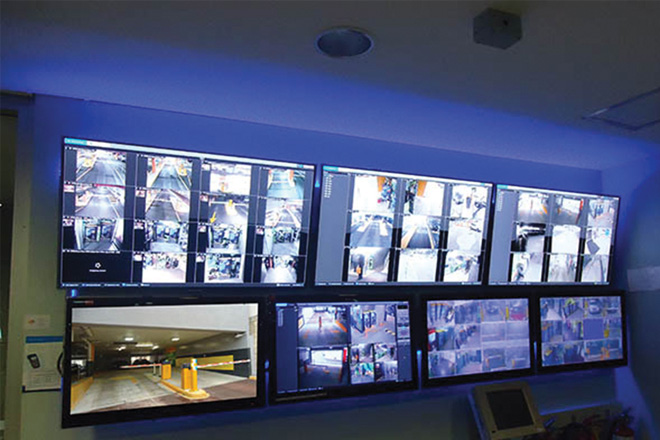Article by Bobby Brasher, Brook Hill School
Feature image courtesy of Brook Hill School. This monitoring station is one of four that officers use to quickly locate footage of school buildings.
Brook Hill School first invested in cameras to protect our on-campus museum. It houses two actual helicopters, an airplane used in D-Day and sample letters from every U.S. President among other valuable items. About 21,000 students from public and other independent schools visit each year, and we wanted to protect the property and students. That first installation of cameras was about eleven years ago.

Our school population has grown and changed since then, as has the world around us. Now Brook Hill has more than 100 cameras and four monitoring stations, three license plate readers and an integrated controlled access system. Why such a dramatic increase? One reason is that we now enroll 110 international boarding students, many of whom come from cultures where security is very important. Some are from high-profile families and are high-risk abduction targets. Our geographic location also plays a role. Brook Hill is in East Texas, where our families prioritize student protection and school security, and likely have a different view about what that looks like than parents in the Northeast or the West Coast, for instance. As a consultant and frequent speaker on school security issues, however, I’ve noticed increased interest in school security technology at all levels from around the country.
If your school is thinking of increasing its use of surveillance cameras, here are a few areas to keep in mind:
Installation and Monitoring
To place cameras effectively, someone with a background in both security surveillance and school safety should be involved. Brook Hill has put up new buildings recently, and I’ve found the places where architects and builders suggest placing the cameras are not the most effective.
The first consideration is how many cameras to use. First we would typically monitor entrances, exits and high-traffic areas where students, parents, staff and visitors gather. Those areas alone can require quite a few cameras. Developing one-year, three-year and five-year plans for security technology use can allow you to slowly expand your coverage.
Most schools post signs that state that the school campus is under video surveillance.

Once installed, cameras won’t take care of themselves, and those supervising them must know what to look for. Four staff members at Brook Hill monitor our cameras: the attendance clerk watches entrances; the international boarding assistant watches areas between our dorms and school facilities; our athletic administrative assistant watches the parking lot and athletic facilities; and the live feed on my phone is locked on the six most important shots of the day. This depends on what activities are taking place and where. All of our camera monitors are trained to identify issues and any problem areas. Additionally, other administrators and emergency response team members can monitor the cameras on their phones at any time.
Recently we were looking for a student who hadn’t shown up to class. When I got the call, I was on the athletic field, but on my phone monitoring app, I spotted the student in question, who was walking to a campus building. I radioed an emergency response team member, who escorted the student back to where she needed to be.
We have also used our swipe key access software and cameras together to quickly locate a student who was rumored to have brought contraband to school during lunch break, when students were scattered in common areas such as the quad and student lounges. The student did in fact have the contraband, and we were able to handle the matter quickly and without incident.
Return on Investment
With the dramatic increase in security technology options, schools are confronted with increased financial hurdles. This is a difficult issue; not many schools have an extra $200,000 sitting around for security.
Another way to think about investments in cameras specifically is that they not only protect the community, but can also save the school money by preventing a lawsuit. For example, we had two students who had a minor accident in the school parking lot. One parent was threatening to take legal action against all parties, but camera footage revealed that it was the angry parent’s child who had in fact caused the accident and was responsible for the damage.
At Brook Hill, we’ve implemented changes slowly, with one-year, three-year and five-year plans for improvements. We’re now at the point where I’m replacing some of our earlier cameras with second generation technology that is not only better, but cheaper. When I first started, a two-megapixel camera cost about $800 dollars, and now a three- to four-megapixel camera costs half as much.
Partnerships can also help. A drone imaging company is beta testing technology at Brook Hill that maps and takes pictures of our campus, then overlays building names. This information will go to law enforcement, so officers will know where to go on campus should there be an emergency.





